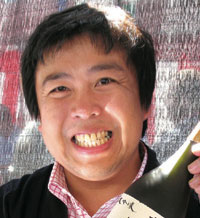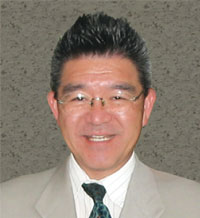Sushi Seki A sushi restaurant that never stops evolving “Sushi Seki”, in Times Square
By Aya Ota
The very Japanese-looking façade of a restaurant that stands out on a busy street called the “Restaurant Row” in Times Square’s Theater District, catches your eyes. It is “Sushi Seki”, which is well known for its high-quality fresh seafood that they serve, and creative sushi, full of seasonal ingredients that you can enjoy.
Seki Shi, the owner/chef, is from the Fujian Province of China. He went to Tokyo to study at the age of 17. There, he opened his eyes to cooking, and distinguished himself. He went to New York in 1991, and worked at various notable restaurants including “Sushi of Gari” before he became independent, and opened “Sushi Seki” in the Upper East Side District.
Then, he opened two more restaurants 2 years in a row, the second one in Chelsea in January of 2014, and the third one in Times Square in October of 2015. Opening of another in Brooklyn is also in the works. People usually believe that the more authentic the sushi restaurant is, the harder it would be to expand the business to multiply, because in order to have such success, it heavily relies on the capabilities of artisans. I wonder what kind of dynamic power has been supporting this unstoppable advance.
“The Times Square restaurant is hugely different from the other two. It is positioned as the flagship, which represents integrated forms of various styles,” says Yasuyuki Suzuki, the General Manager.
Inside of this restaurant is a luxurious space with 80 seats on the first floor, and 70 on the second floor. Once you step inside, a spacious counter and tables open up in front of you. There is a space called the“Kappo Room” in the back, where a counter, tables, and a communal table are situated facing the open kitchen. On the second floor, there is a bar, where you enjoy mostly Japanese whiskey drinks, terrace tables by the windows, a private Japanese room, and a hide-out-like space where you enjoy omakase-style sushi. This place can accommodate every situation; business meetings, family get-togethers, large groups, couples on a date, or a single customer.
The menu, which used to contain mostly sushi, has been largely evolved. The Kappo cuisine aspect was launched due to Chef Seki’s strong hope and intention to take “restaurant cooking” as a whole, seriously. They serve a wide variety of seasonal a-la-carte dishes. Among them, the “Special Kappo Counter Menu” (from $85), full of both land and ocean ingredients of each season, changes the contents monthly. There are also dishes from which you can feel the changes of Japanese seasons, which you can rarely find in the US such as “Ayu ‘Sweet Fish’ Sansho-Ni”, and “Kogomi ‘Fiddlehead Fern’ with Sesame Sauce”.
There is a menu item, which is unique due to the condition, which is that the restaurant is located in the Theater District. The “Mini Omakase” ($55) is a popular item, which cleverly satisfies both the needs of theater-goers who don’t have much time to eat before shows start, and also the smooth running of the restaurant.
“It is not easy to fill this many seats in this location. To try a vast variety of styles means that it is required to accommodate every customer’s need,” tells Mr. Suzuki about the difficulty of realizing it. He met Seki Shi at “Sushi of Gari” in 2000, when he started his career as a manager. He joined the launch and the operation of the first “Sushi Seki”, but left them for a while between 2005 and 2012, building his career by working for various famous restaurants including “Megu”, “15 East”, and “Sakamai”. When Seki Shi was preparing to open the second Sushi Seki, he was asked to join the project again.
Mr. Suzuki is in charge of managing everything for all the restaurants in the chain except cooking. He acquires customers, hires staff members, teaches them how to serve, and even creates the ambience of each restaurant. By being a leading sake sommelier of New York, he put his strong efforts into creating their drink menus, and contributed to help them win the fabulous “NYC50” award in the “Wine and Spirits Magazine” 2 years in a row. It is very rare that a dink menu from a Japanese restaurant gets selected. In 2017, they were the only Japanese restaurant winner. I was so impressed with not only the good balance they show in every field, the great variety, and the depth, but also the contents which skillfully offer customers the ease of selection, and for the staff to make recommendations.
Mr. Suzuki is supporting the restaurant’s super success by being the other wheel of Seki, by creating drink menus to enhance Seki’s cooking, and handling the management, etc. With his principle, “there is no manual for hospitality”, he produces a superbly comfortable space which possesses both a home-like atmosphere and sophistication.
I would really like you to try “Sushi Seki”, which continue to evolve all the time.
決して進化を止めることのない寿司店『すし石』タイムズスクエア店
タイムズスクエアの劇場街、“レストラン通り” と呼ばれる賑やかな通りに、忽然と現れる純和風の店構えに目を奪われるーここ『すし石』は、高品質で鮮度の高い魚介類を使い、季節感あふれる創作寿司を楽しめることでよく知られる店だ。
オーナー・シェフの石氏は中国福建省出身。17歳で東京へ留学、そこで料理に目覚め頭角を現した。1991 年にニューヨークに渡り、『Sushi of Gari』をはじめとする名店で活躍後、2002 年に独立。アッパーイースト地区に『すし石』を開店した。
そして、2014年1月に2店舗目となるチェルシー店、2015 年10 月には3 店舗目となるタイムズスクエア店を立て続けに開店。近々、ブルックリンでの開店計画も進行中だ。本格的な寿司店ほど、職人個人の技量に頼るところが大きく、多店舗展開が難しいと思われがちだが、この快進撃を支える原動力とは一体何だろうか。
「タイムズスクエア店はこれまでの2店舗とは大きく違う。さまざまな形態を総合的に展開するフラッグシップ店として位置づけている」と語るのは、ジェネラル・マネジャーの鈴木康之氏。
1階に80席、2階に70席という贅沢な空間。一歩足を踏み入れると、広々としたカウンター席とテーブル席が続く。奥には「Kappo Room」と呼ぶ空間があり、そこにはオープンキッチンに面したカウンター席、テーブル席、コミューナル・テーブルが配置されている。2階に上がると、日本産ウィスキーを中心に楽しめるウィスキー・バー、窓際のテラス席、座敷の個室、おまかせ寿司を楽しめる隠れ家風の空間が存在する。商談、家族連れ、団体、デート、一人など、あらゆるシチュエーションに対応できる仕様だ。
寿司が中心だったメニューも大きく進化。「レストランとして真剣に“料理” に取り組みたい」という石氏の強い意向で割烹料理を開始した。月替わりで、四季折々の山海の恵みが満載の「割烹おまかせ(85ドル〜) 」のほか、バラエティ豊かなアラカルトを提供。稚鮎の山椒煮やこごみの胡麻和えなど、米国ではなかなか味わえない日本の季節感だ。
また、劇場街という特殊な立地ならではの試み「ミニおまかせ(55 ドル)」も提供。観劇前で食事時間が十分取れない客からの要望と、店側の運営円滑化を見事に両立させた内容で、好評を博している。
「この立地でこの席数を埋めるのは簡単ではない。さまざまな形態に取り組むということは、あらゆる客のニーズに応える必要があるということ」と、その難しさを語る鈴木氏。同氏は、マネジメントとしてのキャリアを開始した2000年に『Sushi of Gari』で石氏と出会った。その後、『すし石』1 号店の開店・運営に携わった後、いったん離れ、2005 〜12年は『Megu』『15 East』『Sakamai』など、数々の名店で実績を重ねた。そして、石氏が2 号店の開店準備を進めている時、「再び一緒にやってほしい」と請われた。
鈴木氏は、全店で、集客、スタッフ採用・教育、接客、店の雰囲気作りに至るまで、料理以外のマネジメントを統括する。さらに、ニューヨークを代表する酒ソムリエでもある同氏は、飲料メニューにも力を注ぎ、『Wine and Spirits Magazine』で2 年連続「NYC50」に選ばれるという快挙を成し遂げた。日本食店の飲料メニューが選出されるのは非常に稀で、2017 年は同店のみだ。それぞれの分野でのバランスの良さ、種類の多さや奥深さに驚かされるだけでなく、客にとっての選びやすさとスタッフにとっての勧めやすさを両立させた内容は、「さすが」の一言に尽きる。
石氏の料理を引き立てる飲料メニュー、シェフとしての石氏を支えるマネジメント…という具合に、鈴木氏が両輪のひとつとなり、同店の快進撃を支える。「ホスピタリティにマニュアルはない」という信条で、家庭的な雰囲気とお洒落さを併せ持つ、絶妙な居心地の良さを演出する。
常に進化し続ける『すし石』、ぜひ足を運んでみてほしい。
Sushi Seki
(Flagship-Times Square)
365 West 46th Street
New York, NY 10036
Tel: (212) 262-8880
http://www.sushiseki.com/
Mon. 5:00pm-11:00pm
Tues.-Sat. 5:00pm-12:00am
The very Japanese-looking façade of a restaurant that stands out on a busy street called the “Restaurant Row” in Times Square’s Theater District, catches your eyes. It is “Sushi Seki”, which is well known for its high-quality fresh seafood that they serve, and creative sushi, full of seasonal ingredients that you can enjoy.
Seki Shi, the owner/chef, is from the Fujian Province of China. He went to Tokyo to study at the age of 17. There, he opened his eyes to cooking, and distinguished himself. He went to New York in 1991, and worked at various notable restaurants including “Sushi of Gari” before he became independent, and opened “Sushi Seki” in the Upper East Side District.
Then, he opened two more restaurants 2 years in a row, the second one in Chelsea in January of 2014, and the third one in Times Square in October of 2015. Opening of another in Brooklyn is also in the works. People usually believe that the more authentic the sushi restaurant is, the harder it would be to expand the business to multiply, because in order to have such success, it heavily relies on the capabilities of artisans. I wonder what kind of dynamic power has been supporting this unstoppable advance.
“The Times Square restaurant is hugely different from the other two. It is positioned as the flagship, which represents integrated forms of various styles,” says Yasuyuki Suzuki, the General Manager.
Inside of this restaurant is a luxurious space with 80 seats on the first floor, and 70 on the second floor. Once you step inside, a spacious counter and tables open up in front of you. There is a space called the“Kappo Room” in the back, where a counter, tables, and a communal table are situated facing the open kitchen. On the second floor, there is a bar, where you enjoy mostly Japanese whiskey drinks, terrace tables by the windows, a private Japanese room, and a hide-out-like space where you enjoy omakase-style sushi. This place can accommodate every situation; business meetings, family get-togethers, large groups, couples on a date, or a single customer.
The menu, which used to contain mostly sushi, has been largely evolved. The Kappo cuisine aspect was launched due to Chef Seki’s strong hope and intention to take “restaurant cooking” as a whole, seriously. They serve a wide variety of seasonal a-la-carte dishes. Among them, the “Special Kappo Counter Menu” (from $85), full of both land and ocean ingredients of each season, changes the contents monthly. There are also dishes from which you can feel the changes of Japanese seasons, which you can rarely find in the US such as “Ayu ‘Sweet Fish’ Sansho-Ni”, and “Kogomi ‘Fiddlehead Fern’ with Sesame Sauce”.
There is a menu item, which is unique due to the condition, which is that the restaurant is located in the Theater District. The “Mini Omakase” ($55) is a popular item, which cleverly satisfies both the needs of theater-goers who don’t have much time to eat before shows start, and also the smooth running of the restaurant.
“It is not easy to fill this many seats in this location. To try a vast variety of styles means that it is required to accommodate every customer’s need,” tells Mr. Suzuki about the difficulty of realizing it. He met Seki Shi at “Sushi of Gari” in 2000, when he started his career as a manager. He joined the launch and the operation of the first “Sushi Seki”, but left them for a while between 2005 and 2012, building his career by working for various famous restaurants including “Megu”, “15 East”, and “Sakamai”. When Seki Shi was preparing to open the second Sushi Seki, he was asked to join the project again.
Mr. Suzuki is in charge of managing everything for all the restaurants in the chain except cooking. He acquires customers, hires staff members, teaches them how to serve, and even creates the ambience of each restaurant. By being a leading sake sommelier of New York, he put his strong efforts into creating their drink menus, and contributed to help them win the fabulous “NYC50” award in the “Wine and Spirits Magazine” 2 years in a row. It is very rare that a dink menu from a Japanese restaurant gets selected. In 2017, they were the only Japanese restaurant winner. I was so impressed with not only the good balance they show in every field, the great variety, and the depth, but also the contents which skillfully offer customers the ease of selection, and for the staff to make recommendations.
Mr. Suzuki is supporting the restaurant’s super success by being the other wheel of Seki, by creating drink menus to enhance Seki’s cooking, and handling the management, etc. With his principle, “there is no manual for hospitality”, he produces a superbly comfortable space which possesses both a home-like atmosphere and sophistication.
I would really like you to try “Sushi Seki”, which continue to evolve all the time.
決して進化を止めることのない寿司店『すし石』タイムズスクエア店
タイムズスクエアの劇場街、“レストラン通り” と呼ばれる賑やかな通りに、忽然と現れる純和風の店構えに目を奪われるーここ『すし石』は、高品質で鮮度の高い魚介類を使い、季節感あふれる創作寿司を楽しめることでよく知られる店だ。
オーナー・シェフの石氏は中国福建省出身。17歳で東京へ留学、そこで料理に目覚め頭角を現した。1991 年にニューヨークに渡り、『Sushi of Gari』をはじめとする名店で活躍後、2002 年に独立。アッパーイースト地区に『すし石』を開店した。
そして、2014年1月に2店舗目となるチェルシー店、2015 年10 月には3 店舗目となるタイムズスクエア店を立て続けに開店。近々、ブルックリンでの開店計画も進行中だ。本格的な寿司店ほど、職人個人の技量に頼るところが大きく、多店舗展開が難しいと思われがちだが、この快進撃を支える原動力とは一体何だろうか。
「タイムズスクエア店はこれまでの2店舗とは大きく違う。さまざまな形態を総合的に展開するフラッグシップ店として位置づけている」と語るのは、ジェネラル・マネジャーの鈴木康之氏。
1階に80席、2階に70席という贅沢な空間。一歩足を踏み入れると、広々としたカウンター席とテーブル席が続く。奥には「Kappo Room」と呼ぶ空間があり、そこにはオープンキッチンに面したカウンター席、テーブル席、コミューナル・テーブルが配置されている。2階に上がると、日本産ウィスキーを中心に楽しめるウィスキー・バー、窓際のテラス席、座敷の個室、おまかせ寿司を楽しめる隠れ家風の空間が存在する。商談、家族連れ、団体、デート、一人など、あらゆるシチュエーションに対応できる仕様だ。
寿司が中心だったメニューも大きく進化。「レストランとして真剣に“料理” に取り組みたい」という石氏の強い意向で割烹料理を開始した。月替わりで、四季折々の山海の恵みが満載の「割烹おまかせ(85ドル〜) 」のほか、バラエティ豊かなアラカルトを提供。稚鮎の山椒煮やこごみの胡麻和えなど、米国ではなかなか味わえない日本の季節感だ。
また、劇場街という特殊な立地ならではの試み「ミニおまかせ(55 ドル)」も提供。観劇前で食事時間が十分取れない客からの要望と、店側の運営円滑化を見事に両立させた内容で、好評を博している。
「この立地でこの席数を埋めるのは簡単ではない。さまざまな形態に取り組むということは、あらゆる客のニーズに応える必要があるということ」と、その難しさを語る鈴木氏。同氏は、マネジメントとしてのキャリアを開始した2000年に『Sushi of Gari』で石氏と出会った。その後、『すし石』1 号店の開店・運営に携わった後、いったん離れ、2005 〜12年は『Megu』『15 East』『Sakamai』など、数々の名店で実績を重ねた。そして、石氏が2 号店の開店準備を進めている時、「再び一緒にやってほしい」と請われた。
鈴木氏は、全店で、集客、スタッフ採用・教育、接客、店の雰囲気作りに至るまで、料理以外のマネジメントを統括する。さらに、ニューヨークを代表する酒ソムリエでもある同氏は、飲料メニューにも力を注ぎ、『Wine and Spirits Magazine』で2 年連続「NYC50」に選ばれるという快挙を成し遂げた。日本食店の飲料メニューが選出されるのは非常に稀で、2017 年は同店のみだ。それぞれの分野でのバランスの良さ、種類の多さや奥深さに驚かされるだけでなく、客にとっての選びやすさとスタッフにとっての勧めやすさを両立させた内容は、「さすが」の一言に尽きる。
石氏の料理を引き立てる飲料メニュー、シェフとしての石氏を支えるマネジメント…という具合に、鈴木氏が両輪のひとつとなり、同店の快進撃を支える。「ホスピタリティにマニュアルはない」という信条で、家庭的な雰囲気とお洒落さを併せ持つ、絶妙な居心地の良さを演出する。
常に進化し続ける『すし石』、ぜひ足を運んでみてほしい。
Sushi Seki
(Flagship-Times Square)
365 West 46th Street
New York, NY 10036
Tel: (212) 262-8880
http://www.sushiseki.com/
Mon. 5:00pm-11:00pm
Tues.-Sat. 5:00pm-12:00am




















